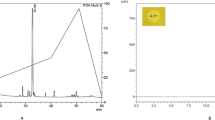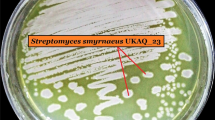Abstract
Multidrug resistance to pathogens has posed a severe threat to public health. The threat could be addressed by antimicrobial peptides (AMPs) with broad-spectrum suppression. In this study, Brevibacillus halotolerans 7WMA2, isolated from marine sediment, produced AMPs against Gram-positive and Gram-negative bacteria. The AMPs were precipitated by ammonium sulfate 30% (w/v) from culture broth and dialyzed by a 1 kDa membrane. Tryptone Soy Agar (TSA) was used for the cultivation and resulted in the largest bacteria-inhibiting zones under aerobic conditions at 25 °C, 48 h. An SDS-PAGE gel overlay test revealed that strain 7WMA2 could produce AMPs of 5–10 kDa and showed no degradation when held at 121 °C for 30 min at a wide pH 2–12 range. The AMPs did not cause toxicity to HeLa cells with concentrations up to 500 µg/mL while increasing the arbitrary unit up to eight times. The study showed that the AMPs produced were unique, with broad-spectrum antimicrobial ability.
Graphical Abstract







Similar content being viewed by others
Data availability
However, for this particular study, we do not have a specific data availability statement to include as the data used are proprietary
Abbreviations
- AMPs:
-
Antimicrobial peptides
- AU:
-
Arbitrary unit
- MICs:
-
Minimum inhibitory concentrations
- HPLC:
-
High-performance liquid chromatography
- ISP2:
-
International streptomyces project-2 medium
- KCTC:
-
Korean collection for type cultures
- MRSA:
-
Methicillin-resistant Staphylococcus aureus
- SDS:
-
Sodium dodecyl sulfate
- TSA:
-
Tryptone soy agar
- WHO:
-
World health organization
References
Huang, Z., Hu, Y., Shou, L., & Song, M. (2013). Isolation and partial characterization of cyclic lipopeptide antibiotics produced by Paenibacillus ehimensis B7. BMC Microbiology, 13, 87.
Andersson, D. I., & Hughes, D. (2010). Antibiotic resistance and its cost: Is it possible to reverse resistance? Nature Reviews Microbiology, 8, 260–271.
Bush, K., Courvalin, P., Dantas, G., Davies, J., Eisenstein, B., Huovinen, P., Jacoby, G. A., Kishony, R., Kreiswirth, B. N., Kutter, E., Lerner, S. A., Levy, S., Lewis, K., Lomovskaya, O., Miller, J. H., Mobashery, S., Piddock, L. J. V., Projan, S., Thomas, C. M., Tomasz, A., Tulkens, P. M., Walsh, T.R., Watson, J. D., Witkowski, J., Witte, W., Wright, G., Yeh, P., & Zgurskaya, H. I. (2011). Tackling antibiotic resistance. Nature Reviews Microbiology, 9, 894–896.
David, L., Brata, A. M., Mogosan, C., Pop C., Czako, Z., Muresan, L., Ismaiel, A., Dumitrascu, D. I., Leucuta, D. C., Stanculete, M. F., Iaru, I, & Popa, S. L. (2021). Artificial intelligence and antibiotic discovery. Antibiotics. https://doi.org/10.3390/antibiotics10111376
Cotter, P. D., Ross, R. P., & Hill, C. (2013). Bacteriocins-a viable alternative to antibiotics? Nature Reviews Microbiology, 11, 95–105.
Umu, Ö. C. O., Bäuerl, C., Oostindjer, M., Pope, P. B., Hernández, P. E., Pérez-Martínez, G., & Diep, D. B. (2016). The potential of class II bacteriocins to modify gut microbiota to improve host health. PLoS One, 11, e0164036–e0164036.
Yang, X., & Yousef, A. E. (2018). Antimicrobial peptides produced by Brevibacillus spp.: Structure, classification and bioactivity: A mini review. World Journal of Microbiology and Biotechnology. https://doi.org/10.1007/s11274-018-2437-4
McIntosh, J. A., Donia, M. S., & Schmidt, E. W. (2009). Ribosomal peptide natural products: Bridging the ribosomal and non-ribosomal worlds. Natural Products Reports, 26, 537–559.
Martinez, F. A. C., Balciunas, E. M., Converti, A., Cotter, P. D., & De Souza Oliveira, R. P. (2013). Bacteriocin production by Bifidobacterium spp. A review. Biotechnology Advances, 31, 482–488.
Huang, E., Guo, Y., & Yousef, A. E. (2014). Biosynthesis of the new broad-spectrum lipopeptide antibiotic paenibacterin in Paenibacillus thiaminolyticus OSY-SE. Research in Microbiology, 165, 243–251.
Shah, P., Hsiao, F. S. H., Ho, Y. H., & Chen, C. S. (2016). The proteome targets of intracellular targeting antimicrobial peptides. Proteomics, 16, 1225–1237.
Hall, K., Lee, T. H., Mechler, A. I., Swann, M. J., & Aguilar, M. I. (2014). Real-time measurement of membrane conformational states induced by antimicrobial peptides: Balance between recovery and lysis. Science and Reports, 4, 5479.
Kranjec, C., Ovchinnikov, K. V., Grønseth, T., Ebineshan, K., Srikantam, A., & Diep, D. B. (2020). A bacteriocin-based antimicrobial formulation to effectively disrupt the cell viability of methicillin-resistant Staphylococcus aureus (MRSA) biofilms. npj Biofilms Microbiomes, 6, 58.
Brogden, K. A. (2005). Antimicrobial peptides: Pore formers or metabolic inhibitors in bacteria? Nature Reviews Microbiology, 3, 238–250.
Baindara, P., Chaudhry, V., Mittal, G., Liao, L. M., Matos, C. O., Khatri, N., Franco, O. L., Patil, P. B., & Korpole, S. (2016). Characterization of the antimicrobial peptide penisin, a class Ia novel lantibiotic from Paenibacillus sp. strain A3. Antimicrobial Agents and Chemotherapy, 60, 580–591.
Miljkovic, M., Jovanovic, S., O’Connor, P. M., Mirkovic, N., Jovcic, B., Filipic, B., Dinic, M., Studholme, D. H., Fira, D., Cotter, P. D., & Kojic, M. (2019). Brevibacillus laterosporus strains BGSP7, BGSP9 and BGSP11 isolated from silage produce broad spectrum multi-antimicrobials. PLoS One, 14, e0216773.
Singh, P. K., Chittpurna, Ashish, Sharma, V., Patil, P. B., & Korpole, S. (2012). Identification, purification, and characterization of laterosporulin, a novel bacteriocin produced by Brevibacillus sp. strain GI-9. PLoS One, 7, e31498.
Yang, X., Huang, E., Yuan, C., Zhang, L., & Yousef, A. E. (2016). Isolation and structural elucidation of brevibacillin, an antimicrobial lipopeptide from Brevibacillus laterosporus that combats drug-resistant Gram-positive bacteria. Applied and Environment Microbiology, 82, 2763–2772.
Sanders, M. E., Morelli, L., & Tompkins, T. A. (2003). Sporeformers as Human Probiotics: Bacillus, Sporolactobacillus, and Brevibacillus. Comprehensive Reviews in Food Science and Food Safety, 2, 101–110.
Le Han, H., Jiang, L., Thu Tran, T. N., Muhammad, N., Kim, S. G., Tran Pham, V. P., Ng, Y. J., Khoo, K. S., Chew, K. W., & Phuong Nguyen, T. D. (2022). Whole-genome analysis and secondary metabolites production of a new strain Brevibacillus halotolerans 7WMA2: A potential biocontrol agent against fungal pathogens. Chemosphere, 307, 136004.
Daba, H., Pandian, S., Gosselin, J. F., Simard, R. E., Huang, J., & Lacroix, C. (1991). Detection and Activity of a Bacteriocin Produced by Leuconostoc mesenteroides. Applied and Environmental Microbiology, 57(12), 3450–3455.
Baindara, P., Singh, N., Ranjan, M., Nallabelli, N., Chaudhry, V., Pathania, G. L., Sharma, N., Kumar, A., Patil, P. B., & Korpole, S. (2016). Laterosporulin10: A novel defensin like class iid bacteriocin from brevibacillus sp. strain SKDU10 with inhibitory activity against microbial pathogens. Microbiology (United Kingdom), 162, 1286–1299.
Elshikh, M., Ahmed, S., Funston, S., Dunlop, P., McGaw, M., Marchant, R., & Banat, I. M. (2016). Resazurin-based 96-well plate microdilution method for the determination of minimum inhibitory concentration of biosurfactants. Biotechnology Letters, 38, 1015–1019.
Nguyen, M. N. T., & Ho-Huynh, T. D. (2016). Selective cytotoxicity of a Vietnamese traditional formula, Nam Dia long, against MCF-7 cells by synergistic effects. BMC Complementary and Alternative Medicine, 16, 220.
Tacconelli, E., Carrara, E., Savoldi, A., Harbarth, S., Mendelson, M., Monnet, D. L., Pulcini, C., Kahlmeter, G., Kluytmans, J., Carmeli, Y., Ouellette, M , Outterson, K., Patel, J., Cavaleri, M., Cox, E. M., Houchens, C. R., Grayson, M. L., Hansen, P., Singh. N., Theuretzbacher, U., & Magrini, N. (2018). Discovery, research, and development of new antibiotics: The WHO priority list of antibiotic-resistant bacteria and tuberculosis. The Lancet Infectious Diseases, 18, 318–327.
Atipairin, A., Songnaka, N., Krobthong, S., Yingchutrakul, Y., Chinnawong, T., & Wanganuttara, T. (2022). Tropical medicine and infectious disease identification and characterization of a potential antimicrobial peptide isolated from soil Brevibacillus sp. WUL10 and Its activity against MRSA pathogens. Tropical Medicine and Infectious Disease. https://doi.org/10.3390/tropicalmed7060093
Benfield, A. H., & Henriques, S. T. (2020). Mode-of-action of antimicrobial peptides: Membrane disruption vs intracellular mechanisms. Frontiers in Medical Technology, 2, 610997.
Ansari, A., Zohra, R. R., Tarar, O. M., Qader, S. A. U., & Aman, A. (2018). Screening, purification and characterization of thermostable, protease resistant Bacteriocin active against methicillin resistant Staphylococcus aureus (MRSA). BMC Microbiology. https://doi.org/10.1186/s12866-018-1337-y
Boix, E., Coroller, L., Couvert, O., Planchon, S., van Vliet, A. H. M., Brunt, J., Peck M. W., Rasetti-Escargueil, C., Lemichez. E., Popoff, M. R., & André, S. (2022). Synergistic interaction between pH and NaCl in the limits of germination and outgrowth of Clostridium sporogenes and Group I Clostridium botulinum vegetative cells and spores after heat treatment. Food Microbiology, 106, 104055.
Hoang, L. H., Nga, T. T., Tram, N. T., Trang, L. T., Ha, H. T. T., Hoang, T. H., Anh, D. D., Yen, P. B, Nguyen, N. T., Morita, M., Kenri, T., & Senoh, M. (2022). First report of foodborne botulism due to Clostridium botulinum type A(B) from vegetarian home-canned pate in Hanoi Vietnam. Anaerobe, 77, 102514.
Funding
This work was supported by the University of Science and Technology- the University of Danang (T2023_). This research was also funded by the University of Science and Technology, The University of Danang, under grant number T2023-02-35.
Author information
Authors and Affiliations
Corresponding authors
Ethics declarations
Conflict of interest
The authors declared that there are no competing interests.
Additional information
Publisher's Note
Springer Nature remains neutral with regard to jurisdictional claims in published maps and institutional affiliations.
Supplementary Information
Below is the link to the electronic supplementary material.
Rights and permissions
Springer Nature or its licensor (e.g. a society or other partner) holds exclusive rights to this article under a publishing agreement with the author(s) or other rightsholder(s); author self-archiving of the accepted manuscript version of this article is solely governed by the terms of such publishing agreement and applicable law.
About this article
Cite this article
Le Han, H., Pham, P.T.V., Kim, SG. et al. Isolation and Characterization of Antimicrobial Peptides Isolated from Brevibacillus halotolerans 7WMA2 for the Activity Against Multidrug-Resistant Pathogens. Mol Biotechnol (2023). https://doi.org/10.1007/s12033-023-00963-0
Received:
Accepted:
Published:
DOI: https://doi.org/10.1007/s12033-023-00963-0




